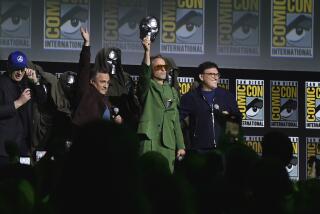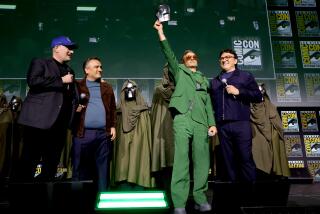Pensive heroes: Long may they fly ... or turn green
- Share via
Who’s been the most lucrative creative force in Hollywood in this short century? You could make an argument for Stan Lee, the irrepressible P.T. Barnum of comic books who, in the 1960s, put pen to paper and came up with Spider-Man, the X-Men, the Fantastic Four, Daredevil and the Hulk -- a colorful parade of properties that in the last six years has grossed $1.6 billion at the box office.
There’s more coming too: Fantastic Four and Spider-Man sequels, a Take 2 effort on the Hulk and the launching of movies about Iron Man, Ant-Man and Thor.
Those future adventures and the old glory days of the Marvel Comics bullpen in the 1960s will be the topics Saturday when Lee and Marvel’s current editor in chief, Joe Quesada, sit down with filmmaker Kevin Smith for a “Marvel: Then & Now” discussion at UCLA. The event is a fundraiser for the Hero Fund, which helps financially strapped comics creators.
Many of the classic characters in comics have generated decades of profit for corporations while the writers and artists who filled the imaginations of youngsters too often have walked away with empty pockets. The classic example is Jerry Siegel and Joe Shuster, co-creators of Superman, who lived in near poverty even as their creation flew into American pop-culture history.
In the late 1970s, with negative publicity on the eve of the release of “Superman: The Movie,” Warner Communications (owner of DC Comics and Warner Bros. Studios) relented and gave the pair a pension and screen credit for the movies.
“I mean, these guys created Superman,” Lee said. “It was a tragedy.”
Lee himself has been the center of some controversy about credit: Critics say that he takes too much of it for the 1960s creative explosion at Marvel and that artists Jack Kirby and Steve Ditko, among others, are given short shrift for their contributions. But the hyperbolic Lee did come up with Marvel’s signature concept: the troubled hero.
“I thought, ‘What if these guys had personal problems?’ Sure, they could walk on walls or fly, but what if they also couldn’t pay their rent? What if they still have to make a living and have personal relationships and weddings? Or what if people didn’t like them? And I had them live in east Manhattan, a real place, not Gotham City.”
That led to Spider-Man’s girl problems, the Fantastic Four’s family spats and the Hulk’s problem of, uh, well, turning green and angry. All that set Lee’s motley heroes apart from Superman, Wonder Woman and their other slightly stiff predecessors.
Quesada says that approach -- realism interpolated with the fantastic -- is the reason that Lee’s army of the garish now marches on the silver screen. It’s also why today’s Marvel stories portray the familiar heroes clashing over federal policies that are clearly reminiscent of the controversial real-life Patriot Act. “Publish fearlessly. Our motto is, ‘What would Stan do?’ ” he says.
Lee and Quesada will appear at UCLA’s Ackerman Grand Ballroom at 7 p.m. Saturday. Tickets are $20; additional details are at www.heroinitiative.org. Lee will also sign copies of his new book, “Amazing Marvel Universe,” at 7 p.m. Dec. 7 at Barnes & Noble on the Third Street Promenade in Santa Monica.
*
-- Geoff Boucher
More to Read
The biggest entertainment stories
Get our big stories about Hollywood, film, television, music, arts, culture and more right in your inbox as soon as they publish.
You may occasionally receive promotional content from the Los Angeles Times.










